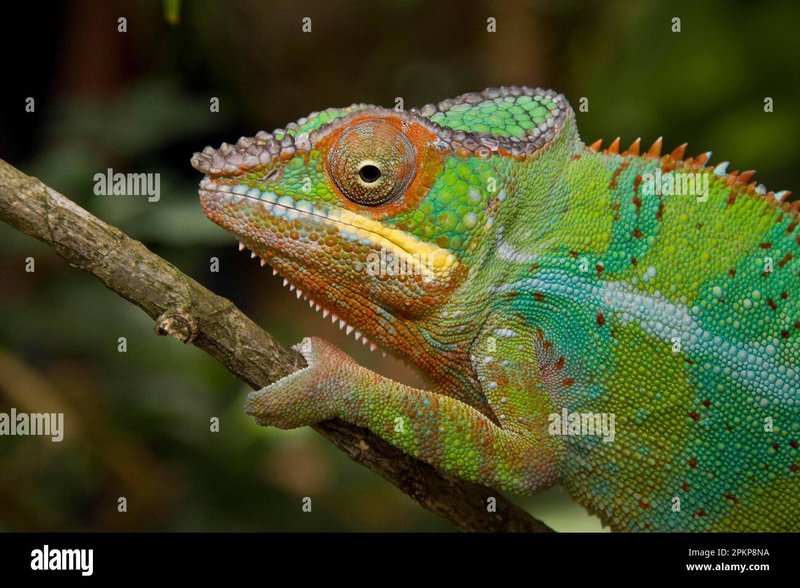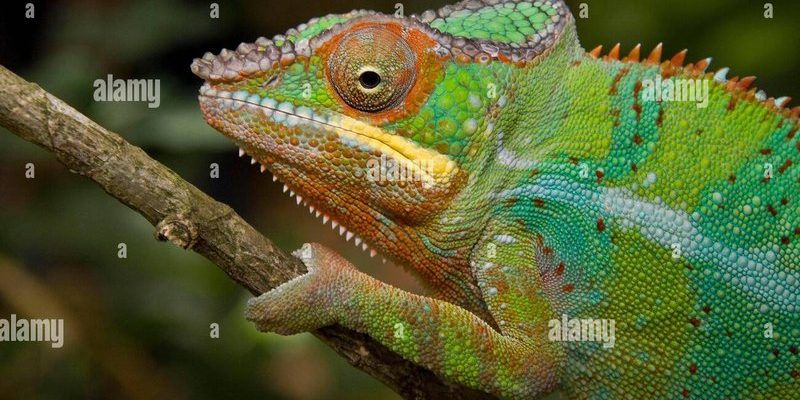
Imagine inviting a loud party-goer who loves attention to a gathering of introverts. The panther chameleon, known for its striking colors and unique personality, might bring a splash of color but can also stir up drama among more laid-back species. Let’s dive into the personality traits and needs of panther chameleons and see how they fare when sharing space with other reptiles.
Understanding Panther Chameleons
Before we jump into compatibility, let’s take a closer look at what makes panther chameleons so unique. Originating from Madagascar, these reptiles are not just visually stunning; they’re also incredibly individualistic. Each panther chameleon has its own personality, which can range from curious and bold to shy and reclusive.
Their color-changing ability is a fascinating feature. It’s not just for camouflage; chameleons change color based on their mood, temperature, and even to communicate with other chameleons. This vibrant display can be mesmerizing, but it’s also a conversation starter—one that doesn’t always end well when mixed with other reptiles.
Since they’re solitary creatures, panther chameleons thrive in their own space. Stress can easily arise in cramped environments or when they feel threatened by other reptiles. So, while they might look good in a group setting, keeping them happy often means keeping them solo.
Social Needs of Other Reptiles
Different reptiles have different social needs, and that’s a key factor in deciding if your panther chameleon can coexist with others. For instance, some reptiles, like bearded dragons, are more social and can thrive in groups, while others, like many types of snakes, prefer solitude.
When you’re considering housing a panther chameleon with another reptile, think about factors like:
- Species behavior: Some reptiles are more territorial or aggressive than others.
- Habitat requirements: Different temperature and humidity needs might create conflicts.
- Dietary differences: If one reptile is a herbivore and the other a carnivore, that can lead to problems during feeding time.
Understanding these behaviors helps ensure that each reptile’s needs are met. If you’re thinking of pairing your panther chameleon with another species, be prepared to do a bit of research.
Compatibility with Other Reptiles
So, do panther chameleons get along with other reptiles? The short answer is: not usually. Most experts recommend keeping them separate to prevent stress and potential harm. They can become highly stressed even by simply seeing or sensing nearby reptiles.
Imagine if you were at a park, and someone you didn’t like was just a few feet away. You’d probably feel uneasy, right? That’s similar to what a panther chameleon might experience if housed with another reptile.
Let’s explore specific examples of common reptiles:
- Bearded Dragons: Generally friendly, but they can be too active for a chameleon, potentially stressing it out.
- Geckos: These creatures tend to be less aggressive, but their activity level and space needs can clash.
- Snakes: Not a good match. Chameleons can be seen as prey, making this combination dangerous.
As you can see, the chances of a peaceful cohabitation with panther chameleons are slim.
Creating a Safe Habitat
If you’re committed to keeping a panther chameleon, you’ll want to create an environment that caters to its needs. The best setup is a spacious terrarium that mimics its native habitat.
Here are some key elements:
- Size: A minimum of 20 gallons is recommended, with vertical space for climbing.
- Humidity: Maintain humidity levels between 50-70% with regular misting.
- Temperature: A basking area should be around 85-95°F, while the cooler side can be around 70-75°F.
This setup not only promotes a healthy lifestyle but also minimizes any stress that could arise from potential interactions with other reptiles.
Signs of Stress in Panther Chameleons
Recognizing when your panther chameleon is stressed is crucial. Often, stress will manifest through behaviors such as:
- Lethargy: If your chameleon is less active than usual, it might be feeling overwhelmed.
- Color Changes: If your chameleon’s colors darken or become dull, that could be a sign of stress.
- Refusing Food: A stressed chameleon may not eat, which can lead to health issues over time.
If you notice any of these signs, it’s important to assess their environment and make changes to ensure they’re comfortable. This is especially crucial if other reptiles are nearby.
Alternatives to Co-housing
If you’re still eager for variety in your reptile habitat, consider alternatives that allow you to appreciate different species without the risk of conflict. You could set up multiple separate enclosures, ensuring each species meets its unique needs.
Some options include:
- Community Tanks: Create a vibrant community in separate tanks for reptiles like geckos, anoles, and skinks.
- Focus on Enrichment: Spend time creating naturalistic settings for your panther chameleon. Use plants, branches, and climbing surfaces to simulate its natural habitat.
- Interactive Times: Spend one-on-one time with your reptiles, allowing for personal interaction without the need for cohabitation.
Embracing these alternatives keeps your panther chameleon happy while still providing a rich experience for you as an owner.
Final Thoughts on Panther Chameleons and Other Reptiles
In conclusion, while the idea of having a panther chameleon rub shoulders with other reptiles might be appealing, the reality often tells a different story. Due to their solitary nature and specific habitat needs, it’s best to keep them alone to ensure they live a stress-free life.
Maintaining a peaceful and healthy environment is what makes reptile ownership rewarding. Understanding the needs of your panther chameleon and respecting its individuality is key. So, if you’re looking for companionship in your reptile journey, remember that sometimes, less is more.

